The Korat, also known as the Si-Sawat, is a stunning cat breed that originated in Thailand over 900 years ago. Known by its distinctive silver-tipped blue-gray coat and heart-shaped face, this cat has won countless admirers for its looks as well as its unique personality. It's considered a symbol of good luck in its native Thailand.
The Korat (pronounced as koh-raht, not core-rat) is a small-to-medium feline with a sturdy, strong build and lively, alert expression. Its large, prominent green or amber eyes amplify this breed’s expressiveness. Korats are very intelligent, loyal, and sociable cats that enjoy spending time with their family, but they can demand attention.
Though fairly rare outside of its native Thai home, there's lots to learn and love about this affectionate cat breed.
Breed Overview
Other Names: Si-Sawat
Personality: Intelligent, social, friendly, demanding, affectionate
Weight: 6 to 10 pounds
Length: 15 to 18 inches
Coat Length: Short hair
Coat Color: Blue-gray with silver tips
Coat Patterns: Solid only
Eye Color: Green is preferred, amber is acceptable
Life Expectancy: 15 to 19 years
Hypoallergenic: No
Origin: Thailand
Korat Characteristics
The lovely Korat doesn't reach full maturity until it's between two and four years of age. But even as an adult, it's not a very large cat, although it is muscular and solid. With its beautiful silvery-blue coat that almost appears to shimmer, this is a cat that demands attention, and indeed, the Korat considers itself to be in charge of its family.
Affectionate and very intelligent, Korats generally get along with adults and children alike, as long as they get plenty of attention on their own terms. While these rare felines generally interact well with other household pets, they can become jealous if they feel the other animal is taking away the recognition that they consider their due.
| Affection Level | High |
| Friendliness | High |
| Kid-Friendly | Medium |
| Pet-Friendly | Medium |
| Exercise Needs | Medium |
| Playfulness | High |
| Energy Level | Medium |
| Intelligence | High |
| Tendency to Vocalize | Medium |
| Amount of Shedding | Low |
History of the Korat
This breed originated in Thailand, formerly known as Siam, where they are formally recognized as a national treasure. Literature indicates that the Korat may have been around as far back as Thailand’s Ayutthaya period, which spanned 1350 to 1767. The most notable book from this time period, The Cat-Book Poems, depicted 17 cat breeds thought to bring luck to their owners. Among the cats listed was the Korat. Because of this, Korats were traditionally given as gifts to brides to bring luck and happiness to the newly married couple.
The Korat first came to the United States quite recently. In 1959, the first Korats, Nara, and Darra were imported from Thailand to the U.S. To this day, most Korat’s lines can be traced back to their Thai roots. Unlike many other cat breeds, today's Korats still closely resemble their ancestors; the breed standards have not changed over time. Nor has the Korat been crossed with any other breed, making the Korat one of the few cat breeds to have remained pure throughout the centuries.
Korat Cat Care
The Korat cat is extremely intelligent, playful, and affectionate. These smart felines can form a close bond with their people and love to be an involved part of your daily activities. Because of this, they do not like to be left alone for long periods of time. They are social cats and love to be with their special person. These cats should have a companion to keep them company, whether that is you or another animal. Being left alone can lead to separation anxiety and an unhappy Korat.
Exercise is important for any cat, and the Korat is no exception. However, unlike some cats, the Korat loves any game they can play with their people. Playtime is bonding time, and these feisty cats soak up every minute of positive interaction with their human companions. Many Korats even enjoy a game of fetch! The Korat’s high intelligence makes it easy to train them, as well. To keep them entertained and challenged, try teaching tricks and giving them puzzle toys.
Keeping your Korat well-groomed will ensure that it remains healthy and clean. With their single-layered short coat, grooming a Korat is a breeze. A weekly brushing or two should be sufficient to keep its shimmering silvery-blue fur shiny and in good condition. Be sure to also regularly trim your Korat’s nails, brush its teeth, and keep its ears clean.
It’s worth noting that this blue cat breed is also generally considered to be low-shedding. Simply stroking the fur of a well-groomed Korat is unlikely to produce the usual flurry of cat hair that can be problematic for many allergy-sufferers. However, they are not entirely hypoallergenic.
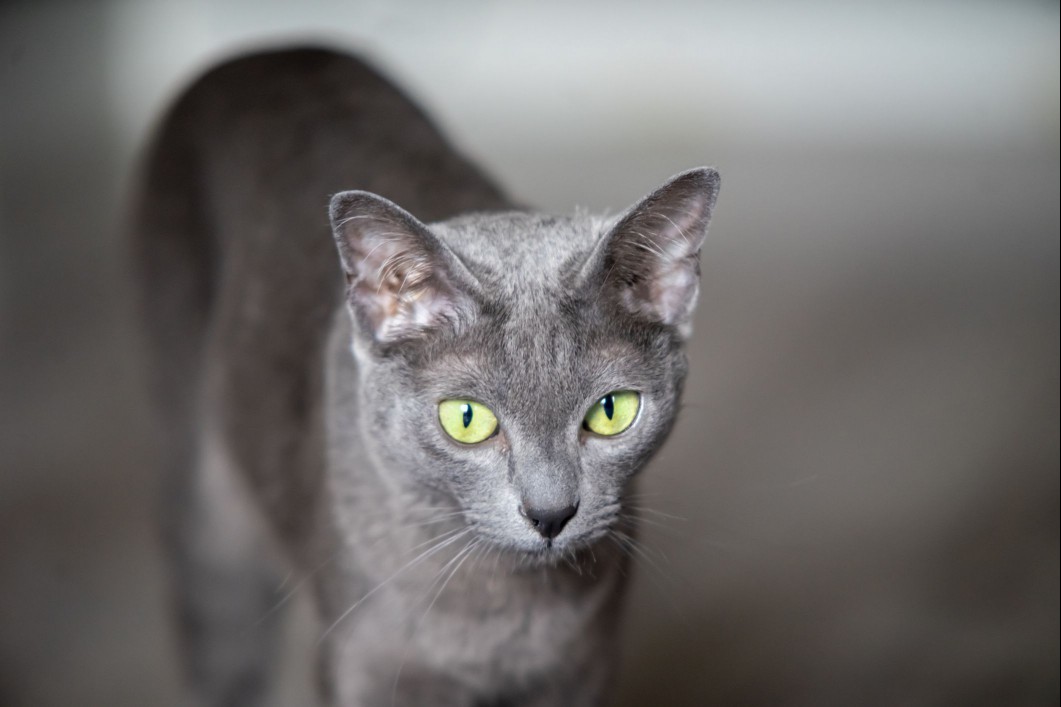
Jacques Julien / Getty Images
Common Health Problems
The Korat is typically quite healthy, but before purchasing one from a breeder, be sure to see written documentation of the health of both parents.
They can be prone to GM1 and GM2 gangliosidosis. This is a rare genetic condition that results in an enzyme deficiency affecting the nervous system. It is fatal but can be discovered by means of genetic testing. It is important that a Korat cat is tested for this disease before breeding.
Appearance
These small-to-medium sized cats have a solid, muscular body that can weigh more than you'd expect. But the really striking thing about a Korat's appearance is its defining fur, which is a silvery blue without any stripes, white markings, or other colors anywhere on the adult cat's body, although faint tabby "ghost" markings are permitted on kittens. The skin on the animal's nose should be blue to lavender, as should the paw pads. The ideal eye color is bright green, but amber is also acceptable. The true eye color is not generally fully developed until the cat is two to four years old.
The head of a Korat is heart-shaped when viewed from the front, with somewhat large, erect ears that give the cat an alert appearance. Their eyes are also large relative to the size of their heads.
Although Korats have very sleek, short fur that isn't prone to much shedding, they are not truly hypoallergenic cats.
Diet and Nutrition
Providing your Korat with high-quality food will help ensure a long and healthy life. Every cat will have its own likes, dislikes, and dietary needs, but a good cat food formulated specifically for the dietary needs of felines should provide all the nutrients your pet needs to thrive. Consult your veterinarian for more information on the diet that best suits your feline.
Keep in mind that while this breed can struggle with a low percentage of body fat, you should also avoid encouraging excessive weight gain or obesity.
Where to Adopt or Buy a Korat Cat
Finding a purebred Korat may be a bit trickier than some other breeds, but a thorough search is worth your effort! These rare cats are unlikely to end up in a shelter or rescue. Your best bet is to visit a cat show, where you'll be able to talk with breeders of many types of cats, possibly including Korats. You can also look for a breeder on The Cat Fancier Association website.
Korat Overview
If your dream cat is intelligent, playful, eager to be the center of attention, affectionate, and gorgeous, then a Korat may be the right breed for you. Granted, these cats are not easy to find, but for the lucky homes that are ruled by the furry paw of a Korat, they are well worth the trouble.
Extremely intelligent
Very loving and can form a strong bond with their people
Low grooming requirements
Can develop separation anxiety if left alone for long periods of time
May become vocally demanding
More Cat Breeds and Further Research
If you like the Korat, you might also be interested in other Asian cat breeds, such as the following:
- Burmese
- Siamese
- Japanese Bobtail
- Nebelung
Otherwise, check out all of our other cat breed profiles.
- Are Korat cats good with kids?
Korats are very affectionate and playful, and they love to spend time with their humans, both young and old. But children need to remain respectful; a Korat has little patience for overly rough play. As long as kids take their cues from the cat, it will welcome play sessions, especially those involving toys such as catnip mice, crinkle balls, and ribbons attached to a stick for chasing.
Do Korats shed a lot?Korats have short fur that doesn't shed nearly as much as many other breeds. Still, your feline needs to be brushed regularly to keep its coat in good health, and you shouldn't expect a Korat to be hypoallergenic.
Are Korats the same as Russian Blue cats?Although Korats and Russian blues both have silvery blue coats, they are not the same breed of cat. Russian blues are somewhat shyer and quieter than Korat cats, and the two have different histories, as well as differences in general appearance.
Related Article
 cat-basic-training
cat-basic-training7 Times Your Cat Acts Exactly Like a Baby
If you’re like most pet parents, your cat has probably become a member of your family. And, hopef
 cat-reproductive-health
cat-reproductive-healthHow Soon Can a Cat Get Pregnant After Having Kittens?
Female cats can become pregnant again soon after having a litter of kittens. It can take only weeks
 cat-preventative-care
cat-preventative-careHow to Avoid 9 Common Cat Owner Mistakes
Bringing home a new feline friend is a major decision. Even though cats have earned a reputation fo
 cat-preventative-care
cat-preventative-careKitten Vaccine Schedule
Your new kitten deserves the best start in life, and this means providing everything she needs to g
 cat-diseases-and-disorders
cat-diseases-and-disordersAnemia in Cats
Anemia is not a disease on its own, but rather, is a sign that there is an underlying health proble
 cat-diseases-and-disorders
cat-diseases-and-disordersCan My Cat Catch My Cold?
If you have a cold, you may wonder if your cat can get this illness too. While cats can be infected
 cat-diseases-and-disorders
cat-diseases-and-disordersUpper Respiratory Infections in Cats
Upper respiratory infections are very common in cats, especially kittens and shelter cats. These co
 short-haired-cat-breeds
short-haired-cat-breedsHavana Brown: Cat Breed Profile
As its name suggests, the Havana Brown cat is a brown-hued cat, but despite the name, the breed doe
About FleaFree Feline
We are a premier digital platform committed to delivering high-quality content to our readers. Our mission is to provide accurate, reliable, and engaging information that adds value to our audience's daily lives.
Our team consists of experienced content creators and subject matter experts who uphold the highest standards of professionalism. In an era of information overload, we curate content with care, ensuring our users receive only the most relevant and trustworthy information.
Beyond just reporting facts, we focus on depth and context. Through expert analysis, comprehensive research, and clear presentation, we help our audience gain meaningful insights and make informed decisions.
We take pride in being a trusted information source for our growing community of readers. Our user-first approach means we continuously adapt to provide content that meets our audience's evolving needs and interests.
Innovation and excellence drive everything we do. We're committed to improving our platform and services to deliver the best possible experience for our users.

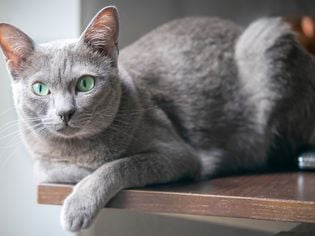
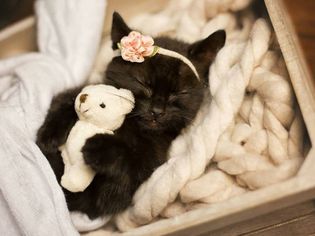
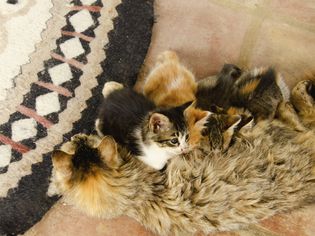
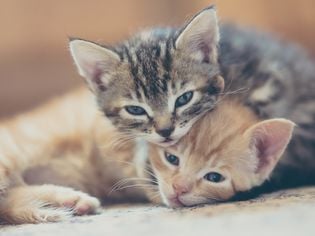
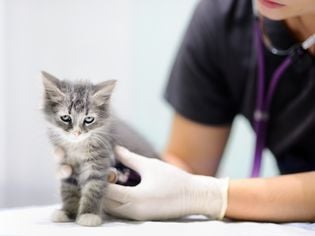


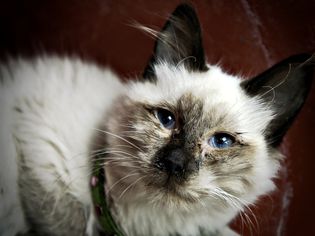
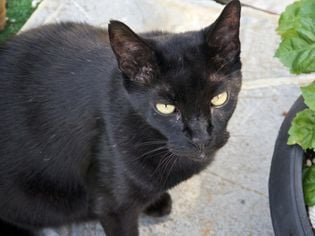
Comments on " Korat: Cat Breed Profile, Characteristics & Care" :